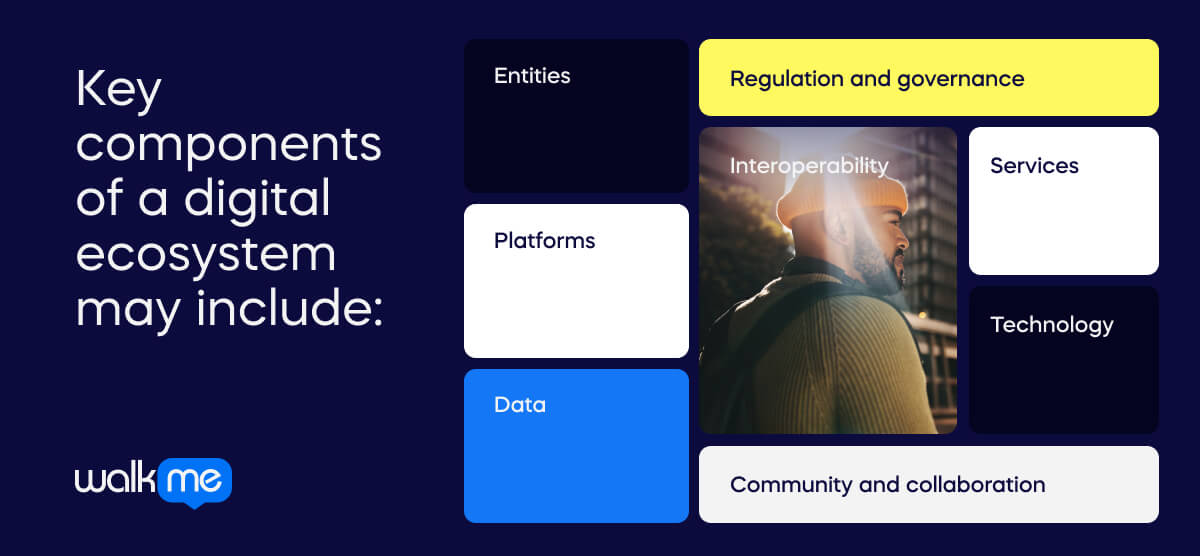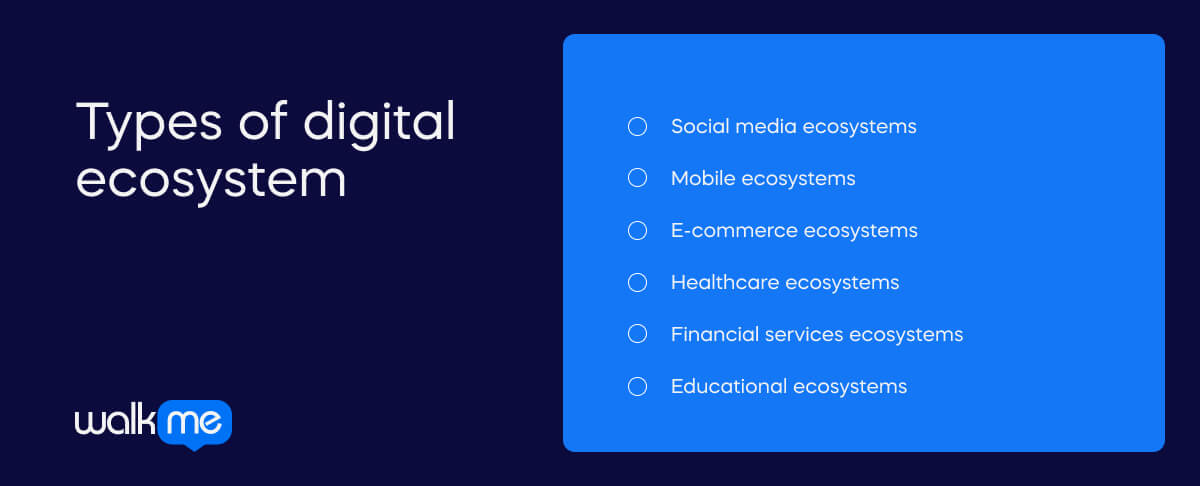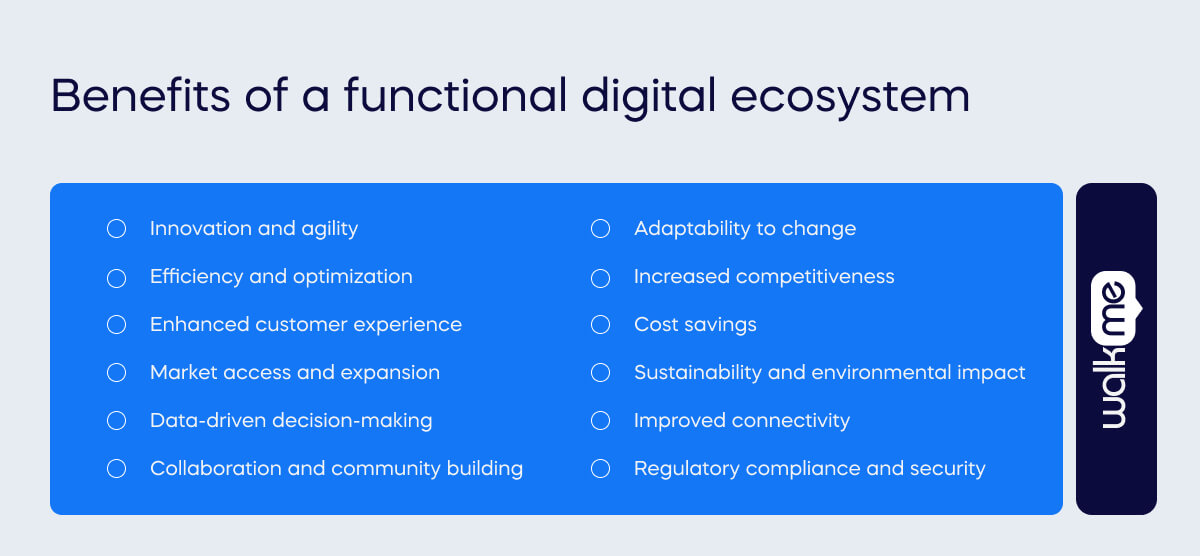What is a digital ecosystem?
A digital ecosystem refers to a dynamic and interconnected network of digital entities, including individuals, organizations, devices, software, and data that interact with each other.

Table of contents
This interaction can be facilitated through digital platforms, technologies, and services, creating an environment where various components collaborate and coexist.
Examples of digital ecosystems include online marketplaces, social media platforms, app stores, and interconnected IoT networks.
The concept is broad and can be applied to various domains, reflecting the increasingly interconnected nature of our digital world.
According to McKinsey, implementing ecosystem strategies has the potential to create substantial value, both through the expansion of the core business and the diversification of the portfolio with new products and services.
Key components of a digital ecosystem may include:

Entities
These are the participants within the ecosystem, such as users, businesses, devices, or software applications.
Platforms
Digital ecosystems often rely on platforms that serve as the foundation for interactions. These platforms can be hardware or software-based and may provide tools, services, or infrastructure for other entities to build upon.
Data
Data is a crucial element in digital ecosystems. It is generated, collected, and shared among entities, contributing to the overall functioning of the ecosystem. Data can be used for analytics, personalization, and decision-making.
Technology
Various technologies, such as cloud computing, the Internet of Things (IoT), artificial intelligence, and blockchain, play a role in shaping digital ecosystems. These technologies enable seamless connectivity, automation, and the processing of large volumes of data.
Interoperability
Successful digital ecosystems often require interoperability, meaning that different components can work together smoothly, even if they come from different providers or sources.
Services
Digital ecosystems offer a variety of services that cater to the needs of their users. These services can include communication tools, applications, and other digital offerings.
Community and collaboration
Collaboration is a fundamental aspect of digital ecosystems. Entities within the ecosystem often collaborate to create value, solve problems, and innovate. Communities may form around shared interests or goals.
Regulation and governance
To ensure ethical and legal operation, digital ecosystems may be subject to regulations and governance structures. These frameworks help manage relationships, data privacy, security, and overall conduct within the ecosystem.
Why are digital ecosystems important?
Digital ecosystems play a pivotal role in modern business and technology environments, enabling seamless integration and collaboration across diverse digital platforms and services. Their significance is rooted in driving efficiency, spurring innovation, and improving customer experiences in an increasingly digital-focused context.
Innovation and collaboration
Innovation is cultivated by bringing together diverse entities such as individuals, businesses, and technologies.
Collaboration within these ecosystems allows for the sharing of ideas, resources, and expertise, leading to the development of new products, services, and solutions.
Efficiency and optimization
Information, resources, and services can be efficiently exchanged. As a result, digital ecosystems typically enjoy optimized processes, reduced costs, and improved productivity.
For example, businesses can streamline their operations by integrating with various partners and leveraging shared platforms.
Interconnectedness and interoperability
In a digital ecosystem, different components can work together seamlessly, even if they come from different providers or sources.
Interconnectedness and interoperability enhance the overall functionality of the ecosystem, providing users with a more integrated and cohesive experience.
Data utilization and analytics
Vast amounts of data are generated and utilized. This data can be leveraged for analytics, insights, and decision-making.
Businesses can gain a deeper understanding of user behavior, preferences, and market trends, leading to more informed strategies and offerings.
Customer experience and personalization
Through data analysis and user interactions, entities within the ecosystem can tailor their services, content, and recommendations to individual preferences, improving overall customer satisfaction.
Market access and expansion
For businesses, participating in digital ecosystems provides opportunities for market access and expansion.
By connecting with partners, reaching a wider audience, and leveraging shared resources, companies can scale their operations and explore new markets more effectively.
Adaptability and flexibility
Digital ecosystems are dynamic and can adapt to changing circumstances and technological advancements.
This adaptability is crucial in a rapidly evolving digital landscape, allowing entities within the ecosystem to stay relevant and responsive to emerging trends and challenges.
Community building and engagement
Communities often form around shared interests or goals. This sense of community can lead to increased engagement, loyalty, and a sense of belonging among participants, whether they are individuals, businesses, or other entities.
Economic growth and competitiveness
The development and success of digital ecosystems contribute to economic growth by fostering innovation, creating new business opportunities, and increasing competitiveness on a global scale.
Sustainability and scalability
Digital ecosystems can be designed with sustainability and scalability in mind.
This means they can grow and adapt without compromising their environmental impact, making them more resilient in the long term.
Types of digital ecosystem

Digital ecosystems can take various forms based on their focus, purpose, and the types of entities involved. Here are several types of digital ecosystems:
Social media ecosystems
- Entities: Users, content creators, advertisers.
- Platforms: Social media platforms like Facebook, Twitter, Instagram.
- Services: Social networking, content sharing, advertising.
Mobile ecosystems
- Entities: Mobile device users, app developers, device manufacturers.
- Platforms: iOS (Apple), Android (Google).
- Services: Mobile apps, app stores, mobile operating systems.
E-commerce ecosystems
- Entities: Buyers, sellers, logistics providers.
- Platforms: Online marketplaces like Amazon, eBay.
- Services: Online shopping, payment processing, order fulfillment.
Healthcare ecosystems
- Entities: Patients, healthcare providers, pharmaceutical companies.
- Platforms: Electronic health record systems, telemedicine platforms.
- Services: Health monitoring, telehealth, data analytics.
Financial services ecosystems
- Entities: Banks, financial institutions, users.
- Platforms: Online banking platforms, fintech apps.
- Services: Digital payments, online banking, investment services.
Educational ecosystems
- Entities: Students, educators, educational content providers.
- Platforms: Learning management systems, online education platforms.
- Services: E-learning, collaborative tools, content delivery.
What tools are used to manage an ecosystem?
Managing a digital ecosystem effectively requires a variety of tools designed to integrate, analyze, and optimize various digital components and interactions. These tools range from data analytics software to integration platforms, each playing a vital role in maintaining the health and efficiency of the ecosystem.
Platform and integration tools
APIs (Application Programming Interfaces): Enable communication and integration between different software applications and services.
Middleware: Software that connects disparate systems, applications, and databases to facilitate communication and data exchange.
Collaboration and communication tools
Collaboration platforms: Tools like Slack, Microsoft Teams, or Asana that facilitate communication and collaboration among ecosystem participants.
Project management software: Helps manage tasks, timelines, and resources efficiently.
Analytics and business intelligence tools
Data analytics platforms: Tools like Google Analytics, Tableau, or Power BI for analyzing and gaining insights from the data generated within the ecosystem.
Business intelligence tools: Provide reporting and visualization capabilities for informed decision-making.
Customer relationship management (CRM) tools:
CRM Platforms: Tools like Salesforce or HubSpot to manage customer interactions, track leads, and enhance customer relationships.
Security and compliance tools
Security software: Tools like antivirus programs, firewalls, and intrusion detection systems to protect against cyber threats.
Compliance management software: Helps ensure adherence to regulatory requirements and standards.
Digital marketing tools
Marketing automation platforms: Tools like HubSpot or Marketo for automating marketing processes and campaigns.
Social media management tools: Facilitate the management of social media accounts and content distribution.
Customer support and service tools
Help desk software: Manages customer inquiries, requests, and support tickets.
Chatbots and virtual assistants: Provides automated assistance and support.
Cloud computing services
Cloud platforms: AWS, Azure, Google Cloud or similar provide infrastructure, storage, and computing resources for digital ecosystems.
Content management systems (CMS)
CMS platforms: Tools like WordPress or Drupal for managing and delivering digital content within the ecosystem.
Monitoring and performance tools
Network monitoring tools: Ensure the performance and reliability of the ecosystem’s infrastructure and connectivity.
Application performance management (APM) tools: Monitor and optimize the performance of software applications.
Benefits of a functional digital ecosystem

A functional digital ecosystem offers a wide range of benefits that can significantly impact businesses, communities, and individuals. Here are some key advantages:
Innovation and agility
- Facilitates collaboration and information sharing, fostering innovation through the exchange of ideas, technologies, and expertise.
- Enables quick adaptation to emerging technologies and changing market conditions.
Efficiency and optimization
- Optimizes workflows and processes, reducing redundancies and improving overall efficiency.
- Maximizes the use of resources, including data, infrastructure, and talent.
Enhanced customer experience
- Allows for personalized experiences based on user preferences and behavior.
- Provides users with seamless and integrated interactions across various services and platforms.
Market access and expansion
- Provides businesses with access to a broader market and a global audience.
- Creates opportunities for expansion and diversification of products and services.
Data-driven decision-making
- Harnesses the power of data analytics to gain valuable insights for informed decision-making.
- Enables real-time access to critical data, allowing for more agile and data-driven strategies.
Collaboration and community building
- Encourages collaboration among ecosystem participants, leading to the creation of vibrant communities.
- Facilitates the sharing of resources, expertise, and best practices.
Adaptability to change
- Allows for scalable growth, accommodating an increasing number of users, transactions, and data.
- Adapts to technological advancements and changing user expectations.
Increased competitiveness
- Drives the development of innovative products and services, enhancing a business’s competitiveness.
- Promotes agile and responsive operations, positioning businesses to react quickly to market shifts.
Cost savings
- Reduces unnecessary costs by optimizing resource allocation and utilization.
- Takes advantage of the cost-effectiveness and flexibility of cloud computing services.
Sustainability and environmental impact
- Promotes the efficient use of resources, contributing to sustainability goals.
- Supports remote work and collaboration, potentially reducing the environmental impact associated with commuting.
Improved connectivity
- Enhances connectivity between services and platforms, creating a more seamless user experience.
- Allows for integration across different technologies and devices.
Regulatory compliance and security
- Supports adherence to regulatory requirements and industry standards.
- Provides centralized security measures to protect data and ensure privacy.
Business risks of an unmanaged ecosystem
An unmanaged digital ecosystem can pose several business risks that can negatively impact operations, reputation, and profitability. Some of these risks include:
Security vulnerabilities
- Weak security measures may expose sensitive data to unauthorized access, leading to data breaches and compromising customer trust.
- Unprotected systems are susceptible to cyber attacks such as ransomware, malware, and phishing, which can disrupt operations and cause financial losses.
Compliance and legal issues
- Failure to manage and secure data properly may result in violations of data protection and privacy regulations, leading to legal consequences and financial penalties.
- Unmanaged ecosystems may lead to breaches of contractual agreements with partners, suppliers, or customers, resulting in legal disputes.
Poor user experience
- Lack of coordination can result in inconsistent user experiences across different touchpoints, negatively impacting customer satisfaction.
- Unresolved technical issues and disruptions may lead to poor user experiences, affecting customer loyalty and retention.
Operational inefficiencies
- Lack of coordination may result in inefficient workflows, leading to delays, errors, and increased operational costs.
- Incompatibility and poor integration between systems can hinder data flow and create bottlenecks.
Data quality and integrity issues
- Inadequate data management may lead to inconsistencies, inaccuracies, and poor data quality, affecting decision-making processes.
- Unmanaged ecosystems may increase the risk of data corruption or loss, impacting the reliability of business-critical information.
Reputational damage
- Security breaches or mishandling of customer data can result in reputational damage and loss of trust.
- Poorly managed ecosystems may lead to negative publicity, damaging the brand image and customer perception.
Financial loss
- Unplanned disruptions, security incidents, and inefficiencies can lead to increased operational costs and financial losses.
- Poor user experiences and reputational damage may lead to a decline in customer acquisition and retention, impacting revenue.
Best practices for managing digital ecosystems
Managing a digital ecosystem effectively is critical for maximizing its potential benefits while minimizing risks. Here are some best practices for managing digital ecosystems:
Define clear objectives
Clearly define the objectives and goals of the digital ecosystem. Understand the purpose it serves, whether it’s improving customer experience, driving innovation, or achieving operational efficiency.
Establish governance framework
Develop a governance framework that outlines roles, responsibilities, and decision-making processes. Establish clear policies for data management, security, and compliance.
Understand stakeholders
Identify and understand the key stakeholders involved in the ecosystem, including users, partners, vendors, and regulatory bodies. Consider their needs and expectations in the ecosystem’s design and management.
Security by design
Integrate security measures into the design and development of the ecosystem. This includes robust authentication, encryption, access controls, and regular security assessments.
Ensure interoperability
Foster interoperability by ensuring that different components of the ecosystem can seamlessly communicate and integrate. Use standardized protocols and APIs to facilitate connectivity.
Data governance
Implement effective data governance practices to ensure the quality, integrity, and security of data within the ecosystem. Define data ownership, classification, and access controls.
Compliance management
Stay informed about relevant regulations and industry standards. Establish processes to monitor and ensure compliance with data protection, privacy, and other regulatory requirements.
Scalability and flexibility
Design the ecosystem to be scalable and flexible to accommodate growth and changing business requirements. Consider the potential need for new technologies, services, or partnerships.
User experience focus
Prioritize user experience by designing intuitive interfaces, ensuring consistency across platforms, and incorporating user feedback into continuous improvement processes.
Strategic vendor and partner management
Select reliable and reputable vendors and partners. Establish clear expectations, service level agreements (SLAs), and regularly assess their performance.
Continuous monitoring and analytics
Implement monitoring tools and analytics to continuously track the performance, security, and user behavior within the ecosystem. Use insights to make informed decisions and improvements.
Agile development and iterative improvements
Adopt agile development methodologies to respond quickly to changing requirements. Implement a cycle of continuous improvement based on user feedback and emerging technologies.
Collaboration and communication
Foster a culture of collaboration and open communication among ecosystem participants. Encourage the sharing of ideas, best practices, and lessons learned.
Training and skill development
Provide training for employees and partners to ensure they have the necessary skills to effectively contribute to and navigate the digital ecosystem.
Disaster recovery and business continuity
Develop robust disaster recovery and business continuity plans to minimize downtime and data loss in the event of system failures, cyber attacks, or other disruptions.
Regular audits and assessments
Conduct regular audits and assessments of the digital ecosystem to identify vulnerabilities, assess compliance, and ensure that it aligns with business objectives.
Adaptability to emerging technologies
Stay abreast of emerging technologies and trends that may impact the digital ecosystem. Evaluate opportunities to incorporate new technologies for improved functionality and competitiveness.
Feedback loops
Establish feedback loops with users and stakeholders to gather insights, address concerns, and identify areas for improvement. Actively listen to the needs of the ecosystem’s participants.
Ethical considerations
Consider the ethical implications of the ecosystem, especially concerning data privacy, user consent, and responsible use of technology.
Documentation and knowledge sharing
Maintain comprehensive documentation of the ecosystem’s architecture, processes, and policies. Encourage knowledge sharing within the team and with relevant stakeholders.